27+ Latest SaaS Statistics For 2024: The Definitive List
Are you looking for the latest SaaS statistics? We’ve got you covered.
Software-as-a-service (SaaS) companies have sprung left and right. They’re everywhere now — and that’s actually a good thing. More companies are switching to SaaS solutions and integrating them into their workflow.
And the valuations that SaaS companies are getting today are off the charts. It only confirms that SaaS companies will continue to explode in the next couple of years.
In this post, we’re sharing the latest SaaS statistics and trends that you need to know.
Editor’s picks
- It only takes around 7 hours to implement new software. (Price Intelligently)
- Software engineers are the biggest users of cloud SaaS. (O’Reilly)
- The median valuation for a public SaaS company today is 15x forward revenue. (Battery Software 2021)
SaaS usage statistics
SaaS products are more popular than you might think. You might already be using one without you knowing it. And there’s plenty of reasons why businesses are shifting from traditional workplace solutions to SaaS technology.
In this section, we’ll show you different SaaS usage statistics to give you a better idea of why it’s being favored by industry influencers these days.
It only takes around 7 hours to implement new software.
Deploying SaaS solutions is no longer as hard as it once was. The average time to fully implement a new software product has gone down from 57 hours a decade ago to 7 hours today.
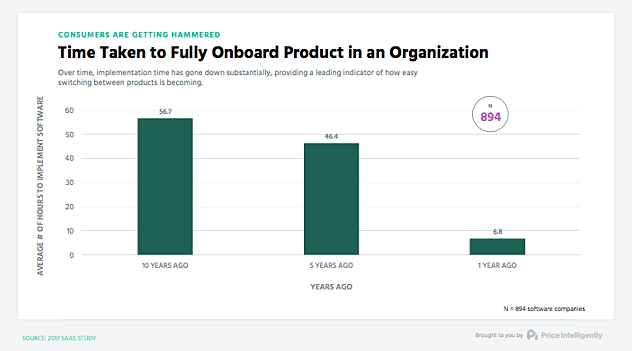
This enables customers to get up and running at record speed.
Source: Price Intelligently
88% of survey respondents use cloud services in one form or another.
In a survey of 1,283 respondents just before the pandemic hit, 88% said that they used cloud services in one form or another. And most of the respondents think that their organizations will grow their usage of cloud services over the next 12 months.
25% said they expected their companies to begin preparations to move all of their applications to the cloud in the next year.
49% of respondents stated that they use a mix of cloud options and that they continue to run applications in a traditional, on-premise setup.
Source: O’Reilly
Software engineers are the biggest users of cloud SaaS.
Of the surveyed SaaS users, 20% of them represent software engineers. Next on the list are technical leads and architects which represent 11% of respondents.
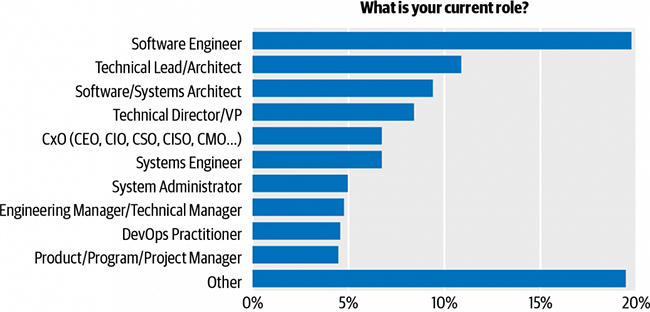
Other roles represented include system architects, technical directors, system engineers, system administrators, DevOps practitioners, and project managers.
Source: O’Reilly
Companies estimate that 70% of apps they use are SaaS-based.
Companies estimate that 70% of the business apps that they use today are based on SaaS. They also add that this will increase to 85% by 2025.
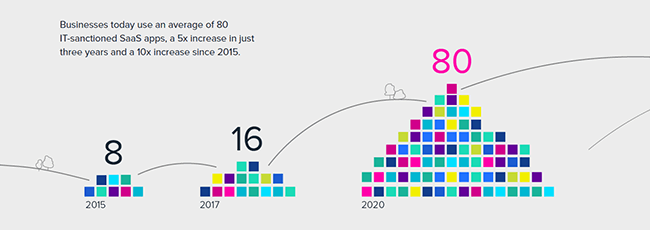
BetterCloud reports that businesses today use an average of 80 IT-sanctioned SaaS apps. That’s a 5x increase over a period of 3 years and a total of 10x since 2015.
Source: BetterCloud State of SaaSOps
Companies that use SaaS can bring new capabilities to market faster.
Companies that have adopted cloud platforms say that they’re able to bring new capabilities to market about 20% to 40% faster. This is because cloud-native companies have the ability to release code into production hundreds or thousands of times per day using automation.
This makes it easier to respond to market demands and quickly test what works (or what doesn’t).
Source: McKinsey
SaaS market statistics
SaaS is a growing industry. And the current market proves that. Different companies—and not just those in the United States—are getting valuations that even experts didn’t see coming years ago.
So how will the market look at SaaS companies years from now? This list of SaaS market statistics might hold the answer.
The median valuation for a public SaaS company today is 15x forward revenue.
In 2010, the median valuation of a SaaS company was only 3 times the forward revenue. Today, the median valuation is 15 times forward revenue. Many companies are trading above 30 times their next-12-months revenue.
One of the reasons why this is the case is that there’s a better understanding of the SaaS business model these days. After all, more than 40 public SaaS companies are generating more than $500 million in revenue every year each.
Source: Battery Software 2021
LinkedIn was the first cloud company to reach a $1 billion valuation.
When cloud companies first started, experts were skeptical about their potential. Even emerging private cloud companies in the year 2000 like Salesforce and Netsuite weren’t spared. But in 2008, the industry saw its first privately-held cloud company reach a $1 billion valuation.
That company is LinkedIn.
And as of February 2020, there’s been more than 86 private cloud “unicorns” like Snowflake, Stripe, Toast, and Procore.
Source: Bessemer Venture Partners
The value of the top 5 public cloud companies increased by 44x.
From 2008 to 2020, the value of the top 5 public cloud companies increased by as much as 44x.
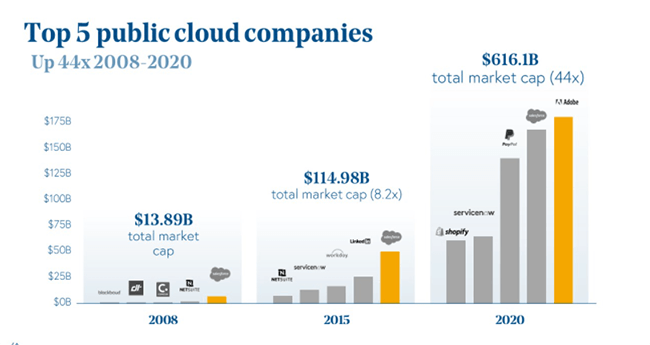
These five companies are Salesforce, CConcur, Netsuite, Dealertrack, and Blackbaud. In 2008, their total market cap was $13.89 billion. By 2015, it rose by 8x. And come February 2020, these five companies’ market cap lingered around %616 billion.
Source: Bessemer Venture Partners
9. SaaS remains the largest public cloud market segment.
By the end of 2020, the SaaS market was estimated to grow to $104.7 billion. This is due to the continued shift from on-premise license software to subscription-based SaaS models. This is especially true since the pandemic hit since there was a need for new software collaboration tools.
The second-largest market in the cloud segment? That would be the Infrastructure-as-a-Service (IaaS) which was thought to grow to 13.4% or %50.4 billion in 2020.
Source: Information Age
India’s SaaS industry is expected to reach $50 to $70 billion by 2030.
According to experts, India’s SaaS industry will reach $50 to $70 billion by 2030. With this development, it’s poised to win 4% to 6% of the global SaaS market by that time.
This is attributed to different factors. One of which is the rise of Indian SaaS companies in the last few years. These companies, altogether, generate $2 to $3 billion in revenue. This market represents 1% of the global SaaS market.
Source: TechCrunch
The web and video conferencing SaaS market will reach $7 billion by 2026.
The global web and video conferencing SaaS market will reach $7 billion by 2026 according to Global Industry Analysts Inc. There is currently a strong demand for web and conferencing apps because companies shifted to a remote workforce setup.
The emergence of technologies like IoT, cloud computing, VR, improved video compression, and AI will support the growing video conferencing market.
Source: Global Industry Analysts Inc. (via PR Newswire)
Note: You can learn more about remote work by reading our post on remote work statistics.
Postman is now the most-valued Indian SaaS startup.
Postman, a 7-year-old Indian SaaS startup, managed to raise $225 million in a new funding round to become the country’s most-valued company in the category. It’s now valued at $5.6 billion.
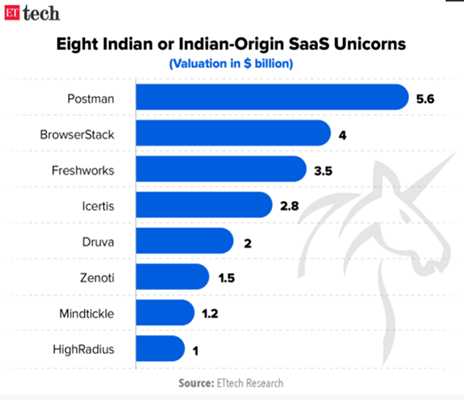
It overtook BrowserStack which as of June 2021 was valued at $4 billion. Another SaaS company, Freshworks, is currently valued at $3.5 billion.
Source: The Economic Times
SaaS business statistics
Just how many SaaS businesses are out there? More than you might think. It’s one of the fastest-growing markets. Because technology keeps on evolving, it’s getting easier for SaaS startups to get their foot in the door.
Here are a few SaaS business statistics that might help you better understand the potential of this booming industry.
There are 15,529 SaaS companies in the world as of June 2020.
According to Crunchbase (via Card Connect), there are 15,529 SaaS companies in the world. This includes companies that were founded all the way back in 1998 that have transitioned to providing SaaS.
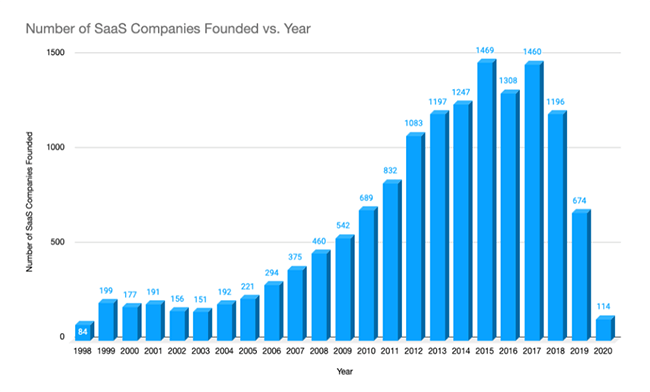
There’s been a decline in SaaS companies founded in 2018 and 2019. That decline doesn’t just represent US companies. The decline represents all companies around the world.
Source: Card Connect
It’s 10x faster to build a software company today.
The reason why there are so many SaaS companies today is because of how easy it is to start one today. Ten years ago, there were just 500 marketing software products. But as of 2020, there were over 8,500.
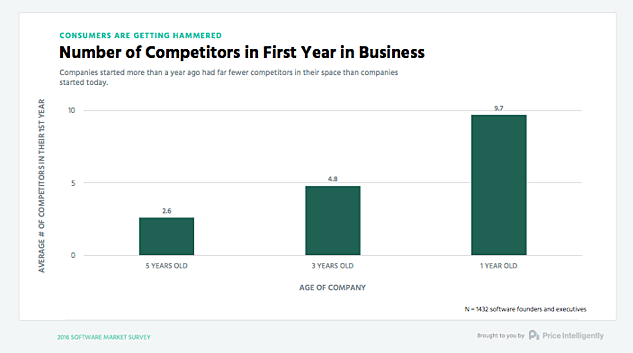
It’s even possible to start a SaaS business within a day given how there are built-in infrastructure solutions like AWS and ready-made website builders available.
Source: Price Intelligently
Covid-19 is changing SaaS payment terms.
Because the pandemic is affecting many businesses, SaaS sales have been affected. That’s why SaaS companies are offering temporary relief on payment terms.
However, a survey revealed that there are SaaS companies that are considering a different approach. A third of the respondents said that they will instead offer additional services. About 30% will offer additional functionality.
Another 30% will offer a temporary price cut — these are mostly companies that sell goods or professional services.
Source: OpenView Partners
Business leaders like how SaaS improved business agility.
Forrester (via Workday) reports that 75% of business leaders moved to a SaaS solution because they noticed that it improved their business agility. 74% also added that this setup is something that they can implement and deploy quickly which is why they have no problem moving to pure SaaS.
Source: Workday
SaaS trend statistics
So where does SaaS go from here? There are a lot of speculations but all of them lean toward a positive outlook. It’s positioned to grow even further in the next couple of years. And every indicator points to organizations committing to SaaS technology as time goes on.
Here are a couple of interesting SaaS trend statistics that show what the future looks like for businesses and SaaS platforms.
95% of workloads will run in the cloud in 5 years.
According to 27% of industry influencers, 95% of workloads will run in the cloud in the next 5 years. 20% think that this will happen in the next 10 years. Others are split on when this will happen. Some think it will happen in the next year while others think it’ll take some time.
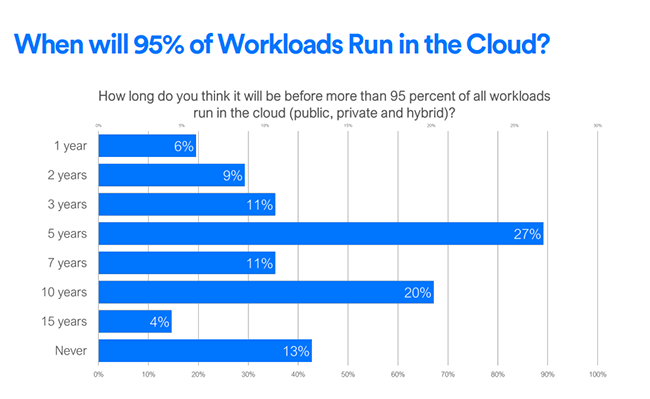
Only 13% think that a public, private, or hybrid cloud setup will not happen.
Source: Logic Monitor
The cloud market is expected to grow to $832.1 billion by 2025.
According to Report Linker, the global cloud market size is expected to grow from $371.4 billion in 2020 to $832.1 billion by 2025. This is at a compound annual growth rate of 17.5% during the forecast period.
This is during a period when digital business transformation has been more challenging and urgent because of the Covid-19 pandemic. SaaS companies are giving their customers affordable and productive solutions as all industries are reeling from the effects of the pandemic on their respective businesses.
Source: Report Linker
SaaS spending is expected to increase by 241%.
SaaS makes it possible for organizations to continue working on their business while facilitating remote work and collaboration. This is even truer today when most people are working from home.
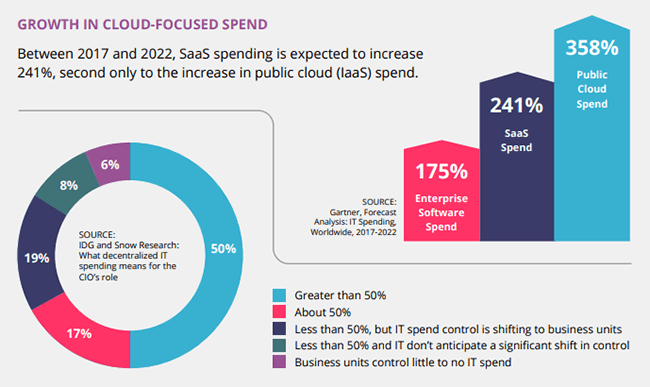
That’s why there are people who think that the future is bright for SaaS. Between 2017 and 2022, SaaS spending is expected to rise by 241%, which is second only to the increase in public cloud spend.
Source: Snow Guide SaaS Cost Management
86% of organizations expect SaaS to meet their software needs by 2022.
According to Insider, 86% of organizations expect most of their software needs to be met by SaaS by 2022.
That’s why it’s no surprise that most people—even those who don’t know or understand what SaaS is—have probably experienced using one such as Google Drive, Dropbox, Slack, or Salesforce.
Source: Insider
SaaS challenges statistics
Despite the benefits of SaaS, it still has its downsides. Security is one of them. With all business information getting sent to and from the cloud, business leaders and IT departments have concerns about cybersecurity.
If you’re thinking about switching to SaaS, you might want to look at all of the challenges that organizations face regarding SaaS technology.
Security is the top concern of organizations using public cloud technology.
In a survey by Logic Monitor of 88 industry influencers, 66% said that security remains one of the biggest challenges of using public cloud services. 60% said that it was governance and compliance.
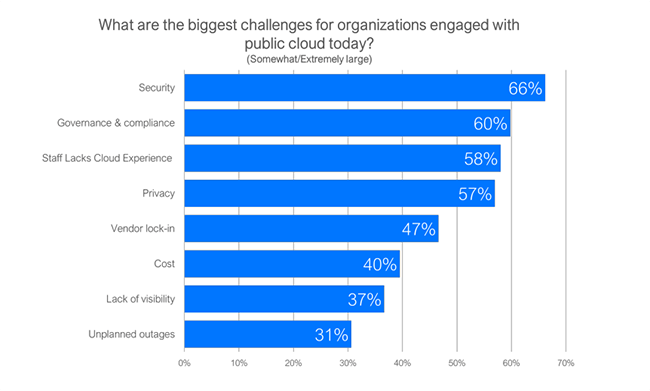
Other concerns include employees lacking cloud experience (58%), privacy (57%), vendor lock-in (47%), cost (40%), lack of visibility (37%), and unplanned outages (31%).
Source: Logic Monitor
IT organizations fear data loss due to SaaS environments.
One of the biggest fears that IT organizations fear when dealing with SaaS is the increased fear of data loss. According to a survey, these organizations believe that all SaaS apps are most likely to hold sensitive business and customer data which includes emails, chats, and calendars.
Another concern is the lack of visibility and control. Only 49% of IT organizations inspire confidence in their ability to monitor and identify unsanctioned SaaS usage in their networks. 76% see unsanctioned apps as a security risk.
There’s also worry that the offboarding process of a single employee from a SaaS app will take up a lot of time and energy.
Source: BetterCloud State of SaaSOps
One out of three employees use SaaS apps that aren’t approved by IT.
IBM (via The Next Web) found out that 1 out of 3 of employees at Fortune 1000 companies regularly use cloud-based SaaS apps that aren’t approved by their respective IT departments.
While it doesn’t appear that the use of unauthorized apps is malicious by nature, it does pose a security risk for companies. For instance, storing confidential files in an app like Dropbox can be risky since it doesn’t have the same security level as other approved apps.
Source: The Next Web
40% of SaaS data access is unmanaged.
A report from DoControl (via VentureBeat) reveals that up to 40% of SaaS data access is unmanaged. This means that anyone with a public or private link can show the data to users outside an organization.
This is bad especially when you consider that most CISOs, CTOs, and CIOs aren’t aware of such a threat. It could result in a massive data breach.
Source: VentureBeat
SaaS statistics sources
Final thoughts
Is SaaS the future of business?
Many seem to think so. Some might even say that it’s inevitable. Now that so many people have experienced working from home during the pandemic, a lot have realized the importance of SaaS for productivity and collaboration.
And because it’s so easy to start a SaaS company today, there are so many rising SaaS “unicorns” that have the potential to dominate the industry in the next five to ten years. We can expect to see more SaaS startups emerge, especially from markets like India.
We cannot overlook the risk associated with using SaaS though. Organizations need to work with their employees on how to use them properly. And they need to tell them that they shouldn’t use SaaS products that aren’t approved by their respective IT departments. Otherwise, they’ll risk the security of their companies.
Overall, the future’s looking bright for SaaS.
Check out our other stats roundups here:
